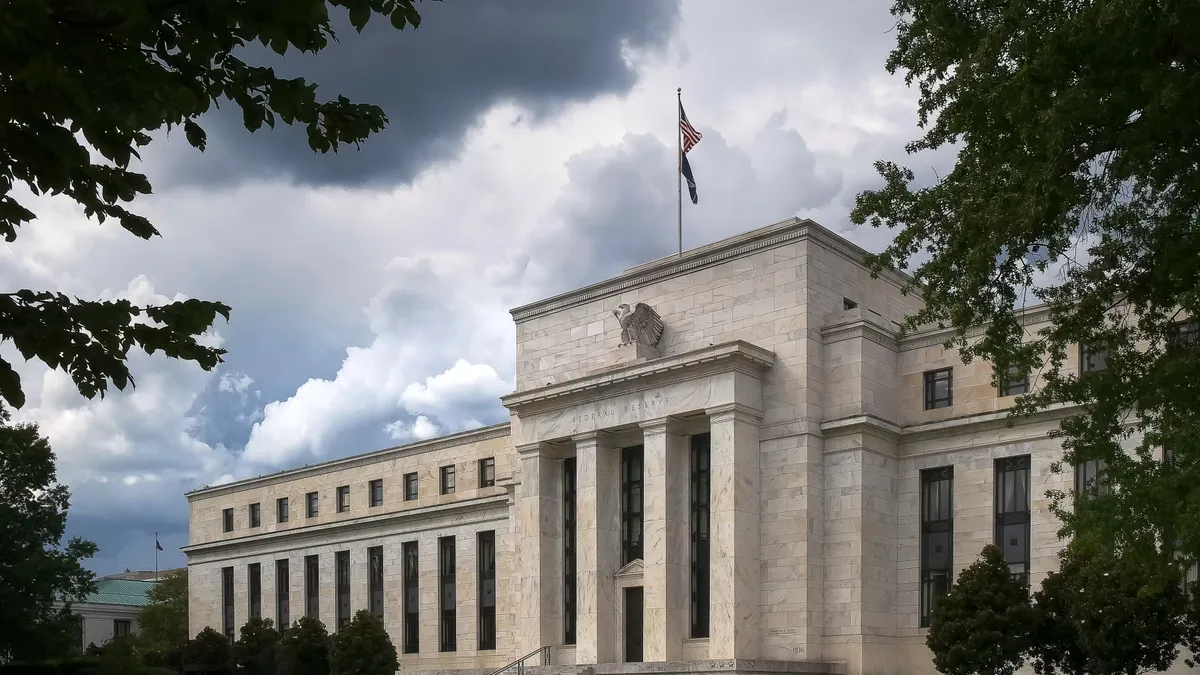Dive Brief:
- Some Federal Reserve officials called for a quarter percentage point hike in the main interest rate last month, opposing a decision to pause the most aggressive increase in borrowing costs in four decades, according to minutes of a gathering of policymakers released Wednesday.
- The meeting “participants favoring a 25 basis point increase noted that the labor market remained very tight, momentum in economic activity had been stronger than earlier anticipated and there were few clear signs that inflation was on a path to return to the [Federal Open Market] Committee's 2% objective over time,” according to the minutes.
- Fed economists affirmed their March forecast that a mild recession will start later this year while noting “continued strength in labor market conditions and the resilience of consumer spending,” the report said. In light of such persistent vitality, “the staff saw the possibility of the economy continuing to grow slowly and avoiding a downturn as almost as likely as the mild‑recession baseline” forecast.
Dive Insight:
The FOMC, gaining time to assess the impact from prior monetary tightening, suspended rate hikes on June 14 even as Fed officials raised their median projection for the federal funds rate at the end of the year to 5.6% from 5.1% in March. The main rate currently is set at a range from 5% to 5.25%.
“A strong majority of committee participants expect that it will be appropriate to raise interest rates two or more times by the end of the year,” Fed Chair Jerome Powell said Thursday in Madrid, adding that “the process of getting inflation back down to 2% has a long way to go.”
The central bank may need to keep the federal funds rate at a restrictive level for as long as three years, Kansas City Fed economists said, noting that policymakers maintained tight monetary policy for three years during two battles against inflation beginning in 1981 and 1988.
“Although monetary policy has recently become restrictive, inflation tends to be sticky, and monetary policy may need to remain restrictive for some time to bring inflation back to the 2% target” set by the central bank, the economists said in a research note published Thursday.
Beginning in March 2022, the Fed raised the federal funds rate at 10 straight meetings before pausing in June.
Yet its effort to curb inflation did not start to slow the economy until the first quarter of this year, the economists said, citing a formula that includes inflation expectations and the “natural rate of interest,” or an inflation-adjusted interest rate consistent with 2% inflation and steady economic growth.
“Policy hasn’t been restrictive for very long,” Powell said on June 28, “so we believe there’s more restriction coming.”
The Fed will probably not succeed at curbing inflation to its 2% goal until 2025, Powell said, referring to so-called core inflation excluding volatile energy and food prices.
“I see us making steady progress,” Powell said, “but I don’t see us getting to 2% this year or next — I see us getting there the year after.”
Traders in interest-rate futures see the Fed easing sooner than Powell suggests. They predict that policymakers this month will raise the federal funds rate by a quarter point and hold it at that peak for several months before beginning to trim the benchmark as early as next March.
On Wednesday they set 89% odds that the Fed will increase the main interest rate to a range between 5.25% to 5.5% on July 26 after a two-day meeting, according to the CME FedWatch Tool. Traders see even odds that policymakers will trim the benchmark by a quarter point or more at their scheduled meeting in March 2024.
Fed officials implicitly acknowledged last month that they had yet to achieve the desired impact after pushing up the benchmark to a 16-year high.
They forecast in a median estimate that their preferred measure for inflation — the core personal consumption expenditures price index — will end the year at 3.9%, an increase of 0.3 percentage point from their forecast in March.
Core PCE in May increased 4.6% compared with a year earlier, a slight dip from 4.7% in April but still more than double the central bank’s target rate.
“Do we have more to do in terms of monetary policy?” New York Fed President John Williams said Wednesday at a meeting of the Central Bank Research Association in New York. “I think the incoming data support that hypothesis.”
Williams, who serves as FOMC Vice Chair, said he fully backed the committee’s decision last month to pause rate hikes.
The inflation data “continues a trend of reports on the economy that show steady, if slow, progress against inflation,” American Action Forum President Douglas Holtz-Eakin said in a report on Monday.
“Most important, any progress is not dramatic enough to dissuade the Fed from its intention to hike rates again in July,” according to Holtz-Eakin, director of the Congressional Budget Office from 2003 until 2005.
Editor’s note: This story was updated with comments by New York Fed President John Williams.












